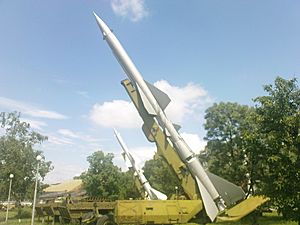Surface to Air Missile facts for kids
A surface-to-air missile (often called a SAM) is a special type of missile launched from the ground or from a ship. Its main job is to shoot down enemy aircraft or other missiles in the sky. SAMs are a key part of Anti-aircraft warfare, which means defending against attacks from the air.
Contents
What Are Surface-to-Air Missiles?
Imagine a shield that protects an area from things flying overhead. That's what SAMs do! They are designed to hit targets like airplanes, helicopters, or even other missiles that are trying to attack. They are very important for protecting cities, military bases, and ships.
How Do SAMs Work?
SAMs work by using different technologies to find and hit their targets.
- Finding the Target: First, a radar system or other sensors find an enemy aircraft. This is like a giant eye that sees things far away.
- Tracking the Target: Once found, the system tracks the target's movement. It figures out where the aircraft is going and how fast.
- Launching the Missile: When the target is in range, the SAM is launched. Some SAMs are launched from large vehicles, others from ships, and some are small enough to be carried by a single soldier.
- Guiding the Missile: After launch, the missile is guided towards the target. This can happen in different ways:
- Radar Guidance: The ground system sends signals to the missile, telling it where to go.
- Heat Seeking: Some missiles follow the heat from an aircraft's engine.
- Active Radar: Some missiles have their own small radar inside to find the target.
- Hitting the Target: The goal is for the missile to get very close to the target. Many SAMs explode near the target, sending out shrapnel (small pieces of metal) to destroy it.
A Brief History of SAMs
The idea of shooting down aircraft from the ground started a long time ago.
- Early Ideas: During World War II, Germany developed one of the first real SAMs called the Wasserfall missile. It was tested but never used in battle.
- First Operational SAMs: The United States created the first SAM system that was actually used, called the Nike Ajax, in the 1950s. It was designed to protect cities from bomber planes.
- Vietnam War: During the Vietnam War, the Soviet Union's S-75 Dvina (also known as SA-2) missiles were very effective. They shot down many American aircraft.
- Modern SAMs: Over time, SAMs became more advanced. They got smaller, more accurate, and could hit targets from much farther away. Some modern SAMs can even shoot down other missiles!
Types of Surface-to-Air Missiles
SAMs come in many shapes and sizes, designed for different jobs.
- Portable SAMs (MANPADS): These are small missiles that a single person can carry and fire from their shoulder. The Strela-2 (SA-7) was one of the first and most common types. They are good for short-range defense.
- Mobile SAM Systems: Many SAMs are mounted on vehicles, making them easy to move around. The Osa system was special because it had everything needed (radar, tracking, and missiles) all on one vehicle.
- Long-Range SAMs: These are very powerful missiles that can hit targets hundreds of miles away and at very high altitudes. They are often used to protect large areas or entire countries. The RIM-161 (SM-3) is an example used by navies.
- Anti-Ballistic Missile (ABM) Systems: Some advanced SAMs are designed specifically to intercept and destroy incoming ballistic missiles, which fly much faster and higher than aircraft. Examples include Israel's David's Sling and Arrow 3 systems. These missiles are incredibly fast and use special guidance systems to hit their targets.
SAMs continue to evolve, becoming smarter and more precise to meet new threats in the sky.
Images for kids
See also
 In Spanish: Misil superficie-aire para niños
In Spanish: Misil superficie-aire para niños












